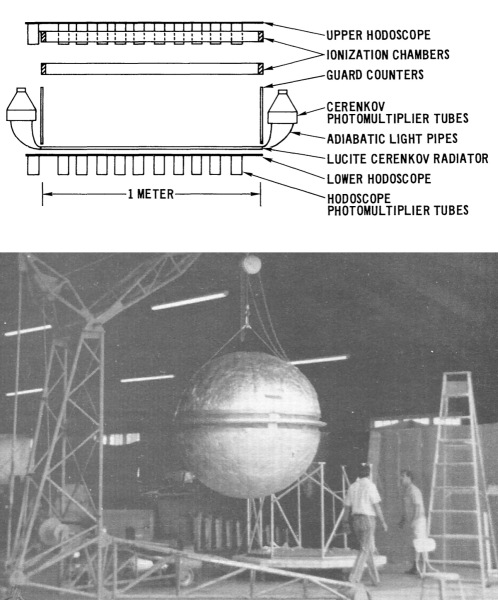Purpose of the flight and payload description
The objective of the flight was to measure the flux and composition of cosmic-ray nuclei with atomic number (Z) greater than 15 and rigidity greater than 4.5 GV. These measurements were made with a balloon-borne large-area detector using ionization chambers and a Cerenkov counter. The instrument was developed at Department of Physics of the Washington University, with the collaboration of the McDonnell Douglas Research Laboratories both from St. Louis.
A schematic diagram of the detector system is shown at left. The principal components were the two pulse-type ionization counters and the Lucite Cerenkov counter. The two parallel-plate ionization counters were 1 square meter in area, 5.1 cm thick, and filled with a mixture of 90% argon and 10% methane at a pressure of one atmosphere. The Cerenkov radiator was a square meter sheet of 0.6-cm thick ultraviolet-transmitting (UVT) Lucite, with light collection by total internal reflection. Each of the four edges of the radiator was viewed by a 12.7-cm photomultiplier (RCA 4525) through an adiabatic light pipe constructed of UVT Lucite.
The particle trajectories were given by a hodoscope consisting of two crossed layers of scintillator strips above the other counters, and two crossed layers below. Each layer consisted of ten strips, giving 9.5 cm resolution. A six-fold coincidence among the four hodoscope layers and the two ion chambers triggered the recording of an event. The ion chamber discriminators determined the experiment threshold and were typically set at a signal level corresponding to a vertically incident relativistic nucleus of charge 16. For each event, the signals from each of the ion chambers and from the Cerenkov counter were pulse height analysed, and the trajectory of the particle was indicated by recording which hodoscope-strip discriminators were triggered.
There were four guard counters, one on each side of the detector square. The guard counters were not in active anti-coincidence, but the outputs of the four guard counter discriminators were recorded for each particle triggering the system.
The experiment was enclosed in an aluminum sphere 59-3/8 inches in diameter. Power supplies, photo barographs, and balloon control instruments were positioned outside the sphere on a support frame which served both as a carrying stand and support frame for honeycomb impact cushion. The entire gondola was then covered with a wall of six-inch thick styrofoam.
Details of the balloon flight
Balloon launched on: 5/17/1970 at 20:24 cdt
Launch site: Columbia Scientific Balloon Facility, Palestine, Texas, US
Balloon launched by: NCAR National Scientific Balloon Flight Station
Balloon manufacturer/size/composition: Zero Pressure Balloon Winzen 10.600.000 cuft (0.7 Mil. CAP. 0.7 Mil. Stratofilm)
Flight identification number: 548P
End of flight (L for landing time, W for last contact, otherwise termination time): 5/19/1970
Balloon flight duration (F: time at float only, otherwise total flight time in d:days / h:hours or m:minutes - ): F 22 h 30 m
Landing site: El Paso, Texas, US
Payload weight: 2083 lbs.
The balloon was launched at 20:24 cdt on May 17, 1970 from National Scientific Balloon Facility in Palestine, Texas. After a nominal ascent the balloon attained an altitude equivalent to 4.26 mb of residual atmosphere. The planned flight of 40 hours at float was reduced to 22 hours due to the trajectory followed by the balloon towards Mexico. The flight was terminated on May 19 and the payload landed safely in El Paso, Texas.
External references
- NCAR Scientific Balloon Facility Annual Report, 1970 National Center for Atmospheric Research, February 1971
- Relativistic Heavy Cosmic Rays Astrophysics and Space Science, Volume 22, Issue 1, pp.45-65
4554If you consider this website interesting or useful, you can help me to keep it up and running with a small donation to cover the operational costs. Just the equivalent of the price of a cup of coffee helps a lot.


